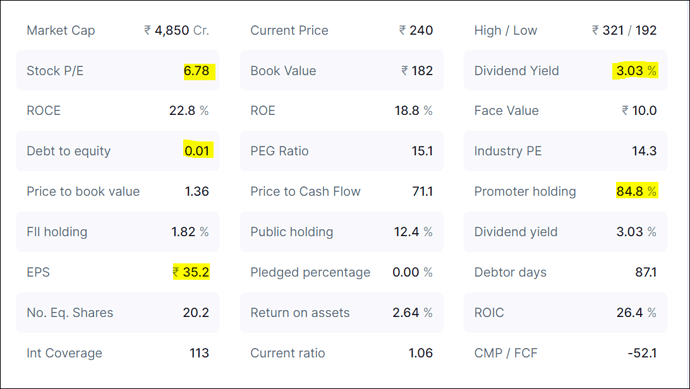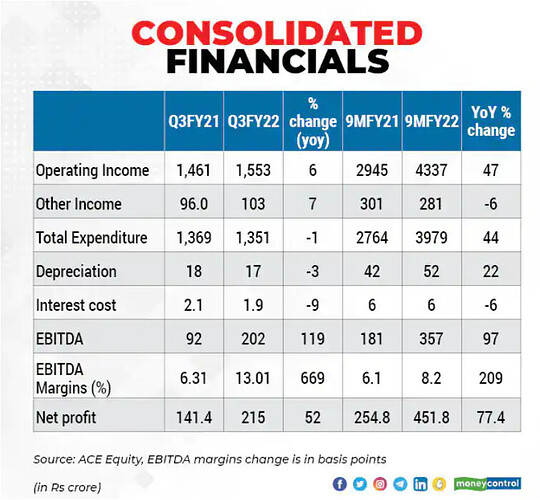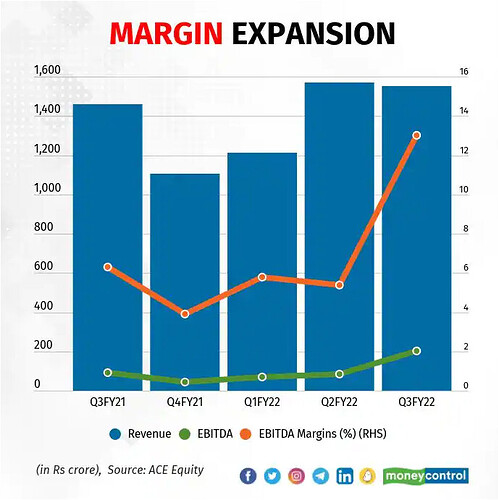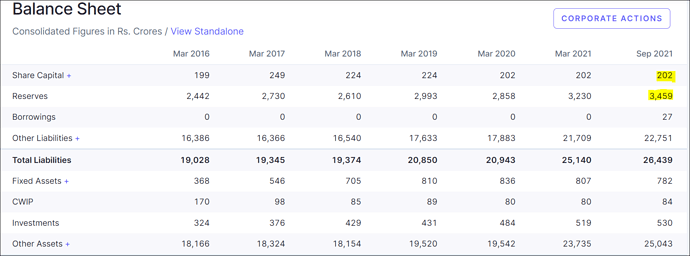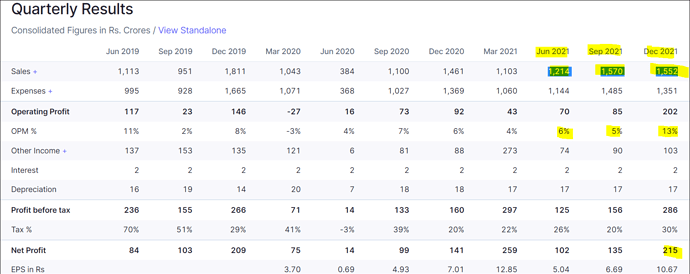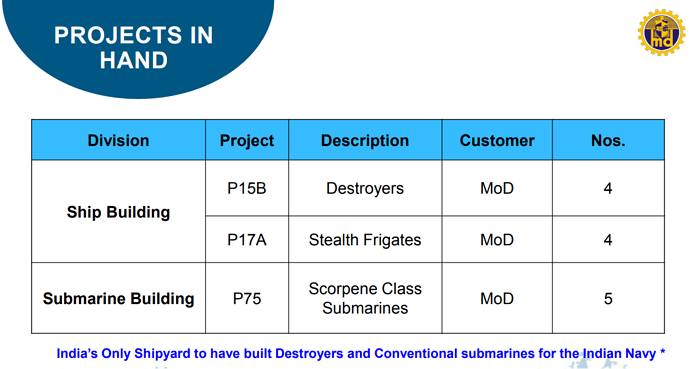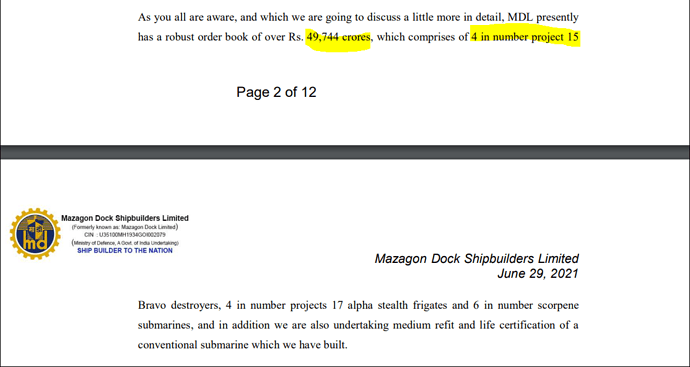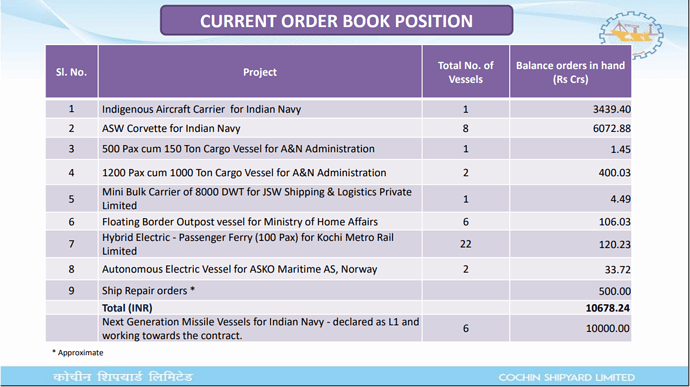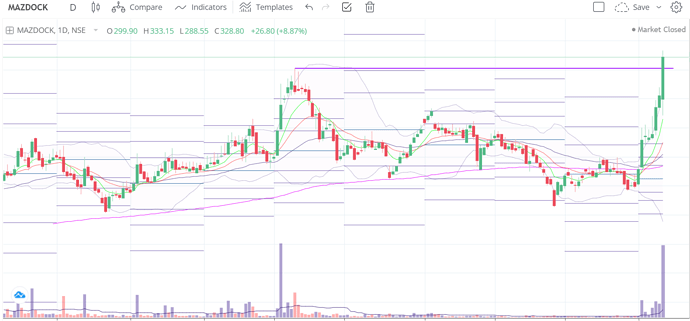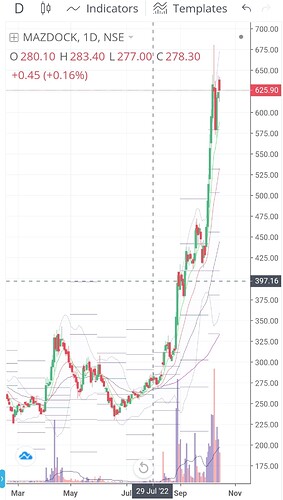About Company
Mazagon Dock Shipbuilders Ltd is primarily engaged in building & repairing of ships, submarines and various types of vessels and related engineering products for various
domestic and international clients
• It was incorporated as a Pvt. company in 1934 and was taken over by the Government of India in 1960.
• The company is a leading player in shipbuilding Industry of India.
• Since 1960, It primarily manufactures for the defence sector and has built 795 vessels including 25 warships ranging from advanced destroyers to missile boats and 3 submarines.
• It has also delivered cargo ships, passenger ships, supply vessels, water tankers, tugs, dredgers, fishing trawlers, barges & border for various customers in India and abroad
• It is the only shipyard to have build destroyers and conventional submarines for the Indian Navy and also one of the initial shipyards to manufacture Corvettes in India.
• Huge growth opportunities going ahead as only 6% of homes in India are currently connected through wireline broadband.
• The company’s dockyard is located in Mumbai which is also headquarters for Western Naval Command of Indian Navy.
• The company is considering an opportunity of developing a greenfield shipyard at Nhava, Navi Mumbai with a ship lift, wet basin, workshops, stores and buildings along with a ship repair facility spread over an area of 40 acres.
Industry Review
The global shipbuilding industry deals primarily with production & modification of larger vessels & rigs that are used for transportation & defence purposes. A characteristic feature of ship-building is that unlike other manufacturing industries, which predominantly follow make-to-stock inventory model, shipbuilding is an order driven industry where each vessel is custom built on receipt of the ship-building order.Thus, building an order book is essential for growth and sustenance of the shipbuilding industry. Order book growth for commercial ships is largely driven by growth
in world trade & commerce, which spurs demand for new ships. Some broad categories of ships include passenger carriers, offshore vessels, dry bulk carriers, tankers, container ships and defence vessels such as destroyers, frigates & corvettes. Average time period required to build a ship depends upon the type & complexity of the vessel. For example, on average it takes 15-18 months to build a conventional vessel, i.e. a bulk carrier or a tanker ship, while it requires 28-32 months to construct an offshore rig or an LNG vessel. Building defence vessels takes even longer as it takes five to seven years on an average to build a destroyer, frigate or a submarine. In the early twentieth century, the shipbuilding industry was largely dominated by Europe. However, later in the century Japan & South Korea overtook the position from Europe by offering lower wages.Thus, the shipbuilding industry in the past few decades has shifted from Europe to Asia due to favourable factors such as cheap labour,competitive manufacturing and steelmaking sectors, as well as state support.
Indian shipbuilding industry
India being an emerging economy is still in the evolving phase of
shipbuilding.The Indian shipbuilding industry based on the types of ships built can be broadly classified as follows:
- Large ocean-going vessels catering to overseas & coastal trade
- Mid-sized specialised vessels, such as port crafts, those for fishing, trawlers, offshore vessels, etc
- Defence/naval craft and coastguard vessels
India’s geostrategic & geopolitical concerns underline the need for a strong & capable Navy and coast guard. Hence, there is need for sustained growth and self-sufficiency of its shipbuilding industry. Traditionally, even as naval ancillary components have been acquired from outside India, actual shipbuilding activity has been carried out indigenously. However, over the years, the government has focused on greater indigenisation of even defence equipment. The domestic shipbuilding industry primarily caters to the Indian Navy, coast guard. Currently, its fleet consists of aircraft carriers, transport dock,landing ship tanks, destroyers, frigates, nuclear-powered submarine,conventionally powered attack submarines, corvettes,mine countermeasure vessels (MCMVs), large offshore patrol vessels, fleet tankers and various auxiliary vessels and small patrol boats. The Indian Coast Guard’s fleet comprises patrol vessels, patrol boats, patrol craft and a hovercraft.In the public sector, shipyards such as GRSE, MDL, CSL & Goa Shipyard have been increasing their focus towards defence.However, MDL is the only Indian shipyard that has built destroyer and conventional submarines for the Indian Navy and is one of the initial shipyards in India to manufacture Corvettes.
MDL has over 200 years of experience in the shipbuilding industry, while traversing from a small single unit ship repair service to multi units, multi products Company.
The company’s facilities currently comprise three dry docks, two wet basins, three slipways, production shops, assembly shops, module shop with painting chamber for integrated construction,sheet metal shop, pipe shop, machine and fitting shop, ship dry dock and dredging, electrical repair shop and instrumentation shop for our shipbuilding division.The marine division infrastructure includes shops for fabrication of frame, sub-section assembly and section formation, cradle assembly shop for structural and equipment outfitting and final assembly, one dry dock and submarine assembly shop.
Strong order book to provide long term topline visibility.
In MDL’s order book comprises of three major shipbuilding projects and two submarine projects.
MDL expects to have a decent order pipeline in the next one to three years with several projects lined up from Indian Navy and Indian Coast Guard worth ~between 20k to 30k crore.
MDL believes it has the competitive advantage for mega projects like six P-75i conventional submarine project (~45000 crore) and six new generation
destroyers (50000 crore) to be finalised over the next three to four years.
MDL is the only player to have earlier built these types of ships and submarines in India.
Any mega order win over the next few years would further propel long term growth.
The strong order book provides long term revenue visibility.
Only shipyard to have built destroyers, conventional submarine
MDL is India’s only shipbuilder to have built destroyers and conventional submarines for Indian Navy.
In the past, it has constructed two SSK submarines and modernised and refitted four SSK submarines.
Since its inception, MDL has built and delivered 795 vessels including 25 warships, from advance destroyers to missile boats and three submarines.
It has also delivered cargo ships, passenger ships, supply vessels, multi-purpose support vessels, water tankers, and tugs, dredgers, fishing trawlers, barges and border outposts for various customers in
India.
MDL is a defence public sector undertaking (DPSU) mainly operating in two business divisions i) shipbuilding and ii) submarine and heavy engineering with maximum shipbuilding and marine capacity 40000 DWT.
The shipbuilding division includes the building and repair of naval ships engaged in construction and repair of naval ships. It is currently building four P-15 B destroyers and four P-17A stealth frigates and repair & refit of a ship for ministry of Defence (MoD).
Submarine & heavy engineering division includes building, repair and refits of diesel electric submarines.
MDL currently building/ in process of delivering four Scorpene class submarines under transfer of technology agreement with Naval group, France and one medium refit submarine for MoD. It has successfully delivered two submarines, INS Kalvari and INS Khanderi.
Financials
Key Risks
Predominantly dependent on MoD for defence orders
Invocation of bank guarantees by customers may impact results
Any decline/delay in defence budget to impact growth, profits
Any delay in procurement, nomination or any other decision by its customer and collaborators may result in time and cost overrun in completion of its shipbuilding and submarine projects.
MDL currently operates from Mumbai, which limits its future expansion programme.
Most of the MDL’s revenues and cash flows are driven from MoD contracts and substantial contracts are on a nomination
basis.
Going forward, orders are likely to be awarded on competitive basis.
Hence there is no assurance that future defence orders will come to MDL only.
Disc: Invested

